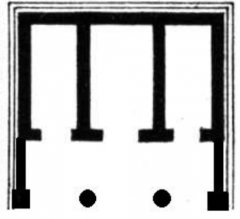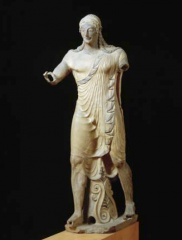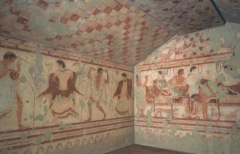![]()
![]()
![]()
Use LEFT and RIGHT arrow keys to navigate between flashcards;
Use UP and DOWN arrow keys to flip the card;
H to show hint;
A reads text to speech;
6 Cards in this Set
- Front
- Back
|
1000 B.C.E. to 270 B.C.E. |
2-4. Etruscan and Roman artists and architects accumulated and creatively adapted Greek objects and forms to create buildings and artworks that appealed to their tastes for eclecticism and historicism. 2-3. Etruscan art, by contrast, is illuminated primarily by modern archaeological record and by descriptions of contemporary external observers. |
|

|
29. Sarcophagus of the Spouses. Etruscan. c. 520 B.C.E. Terra cotta. Approximately 3'9' x 6'7'. |
|

|
31. Temple of Minerva (Veii, near Rome, Italy). (Plan) Master sculptor Vulca. c. 510?500 B.C.E. Original temple of wood, mud brick, or tufa (volcanic rock); terra cotta sculpture. |
|

|
31. Temple of Minerva (Veii, near Rome, Italy). (Elevation) Master sculptor Vulca. c. 510?500 B.C.E. Original temple of wood, mud brick, or tufa (volcanic rock); terra cotta sculpture. |
|

|
31. Temple of Minerva (Veii, near Rome, Italy). (Sculpture of Apollo) Master sculptor Vulca. c. 510?500 B.C.E. Original temple of wood, mud brick, or tufa (volcanic rock); terra cotta sculpture, 5?11?. |
|

|
32. Tomb of the Triclinium. Tarquinia, Italy. Etruscan. c. 480?470 B.C.E. Tufa and fresco. |

